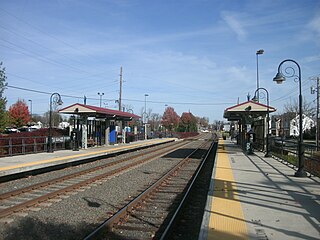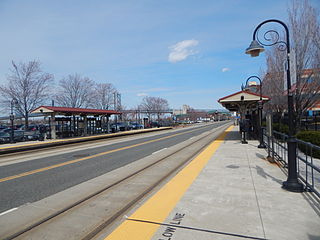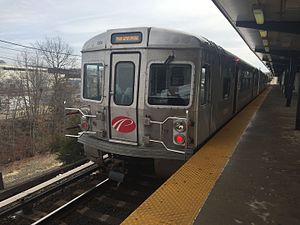
The Southeastern Pennsylvania Transportation Authority (SEPTA) is a regional public transportation authority that operates bus, rapid transit, commuter rail, light rail, and electric trolleybus services for nearly four million people in five counties in and around Philadelphia, Pennsylvania. It also manages projects that maintain, replace and expand its infrastructure, facilities and vehicles.

The Delaware River Port Authority (DRPA), officially the Delaware River Port Authority of Pennsylvania and New Jersey, is a bi-state agency instrumentality created by a congressionally approved interstate compact between the state governments of Pennsylvania and New Jersey. The authority is principally charged to maintain and develop transportation links between the two states with four bridges and a mass transit rail line across the Delaware River. Though the DRPA has "port" in its name, it does not own or operate any ports.

The River Line is a hybrid rail line in southern New Jersey that connects the cities of Camden and Trenton, New Jersey's capital. It is so named because its route between the two cities is parallel to the Delaware River.

The Broad Street Line (BSL), also known as the Broad Street subway (BSS), Orange Line, or Broad Line, is a subway line owned by the city of Philadelphia and operated by the Southeastern Pennsylvania Transportation Authority (SEPTA). The line runs primarily north-south from the Fern Rock Transportation Center in North Philadelphia through Center City Philadelphia to NRG station at Pattison Avenue in South Philadelphia; the latter station provides access to the stadiums and arenas for the city's major professional sports teams at the South Philadelphia Sports Complex, about a quarter mile away. It is named for Broad Street, under which the line runs for almost its entire length. In 2024, as part of the SEPTA Metro plan, the Broad Street Line is expected to be renamed the B Line.

The Market–Frankford Line (MFL), or the Blue Line) is one of three rapid transit lines in Philadelphia, Pennsylvania; it and the Broad Street Line are operated by SEPTA, and the PATCO Speedline is operated by PATCO. The Market–Frankford Line runs from the 69th Street Transportation Center in Upper Darby, just outside of West Philadelphia, through Center City Philadelphia to the Frankford Transportation Center in Near Northeast Philadelphia. From 2024 onwards, this line will be rebranded as the L line.

8th Street station is a subway station complex in Philadelphia, Pennsylvania, at the intersection of 8th Street and Market Street in Center City. It is served by SEPTA's Market–Frankford and Broad–Ridge Spur lines, as well as the PATCO Speedline. The entire complex is owned by SEPTA, while the PATCO areas are leased by the Delaware River Port Authority, which operates that line. 8th Street is the only station in Philadelphia where these three subway lines interchange.

Transportation in Philadelphia involves the various modes of transport within the city and its required infrastructure. In addition to facilitating intracity travel, Philadelphia's transportation system connects Philadelphia to towns of its metropolitan area and surrounding areas within the Northeast megalopolis.

The Atlantic City Line (ACL) is a commuter rail line operated by NJ Transit (NJT) in the United States between Philadelphia, Pennsylvania and Atlantic City, New Jersey, operating along the corridor of the White Horse Pike. It runs over trackage that was controlled by both the Pennsylvania Railroad (PRR) and the Pennsylvania-Reading Seashore Lines. It shares trackage with SEPTA and Amtrak on the Northeast Corridor (NEC) until it crosses the Delaware River on Conrails Delair Bridge into New Jersey.

Lindenwold station is a train station in Lindenwold, New Jersey, United States, served by the NJ Transit Atlantic City Line regional rail service and the rapid transit PATCO Speedline. Lindenwold is the eastern terminus of PATCO; the system's headquarters and maintenance facility are located adjacent to the station in neighboring Voorhees.

Franklin Square station is an unused, underground rapid transit station on the PATCO Speedline, operated by the Delaware River Port Authority. It is located under Franklin Square in Philadelphia, Pennsylvania, United States. Opened on June 7, 1936, the station was the first westbound and final eastbound station in Philadelphia, located just west of the Benjamin Franklin Bridge which carries trains over the Delaware River. The station has been opened for four separate intervals, each time eventually being closed for low ridership. As of 2021, the station is being refurbished and is expected to reopen in April 2024. However, this has been pushed to later in the year.

City Hall station is an underground rapid transit station on the PATCO Speedline, operated by the Delaware River Port Authority. It is located in Camden, New Jersey, one block from Camden City Hall, after which the station is named, at North 5th and Market Streets. Opened on June 7, 1936, the station is the first eastbound and final westbound station in New Jersey, located just east of the Benjamin Franklin Bridge which carries trains over the Delaware River.

Burlington South is a station on NJ Transit's River Line light rail system, located on West Broad Street in Burlington, Burlington County, New Jersey, United States, near the New Jersey side of the Burlington–Bristol Bridge.

Pennsauken–Route 73 station is a station on NJ Transit's River Line light rail system, located on River Road in Pennsauken Township, in Camden County, New Jersey, United States.

36th Street station is an NJ Transit station on the River Line light rail system, located off 36th Street and River Road in the Delaware Gardens neighborhood of Pennsauken Township, in Camden County, New Jersey, United States. It is situated north of Pavonia Yard at the city line with Camden, and as such is the southernmost station of three along the River Line within Pennsauken.

The Walter Rand Transportation Center is a transportation hub located at Martin Luther King Boulevard and Broadway in Camden, New Jersey. It is served by the River Line, New Jersey Transit buses and Greyhound intercity buses and also includes the Broadway station of the PATCO Speedline.

Aquarium station is a station on the River Line light rail system, located on Delaware Avenue in Camden, New Jersey. It is named for the nearby Adventure Aquarium located in on the Camden Waterfront.

Entertainment Center station is a station on the River Line light rail system, located on Delaware Avenue in Camden, New Jersey. It is the southern terminus of the River Line, and is named for the nearby Freedom Mortgage Pavilion on the Camden Waterfront.

Woodcrest station is an at-grade rapid transit station on the PATCO Speedline, operated by the Delaware River Port Authority. It is located in Woodcrest section of Cherry Hill, New Jersey, after which the station is named, near the intersection of Woodcrest Road and Melrose Avenue.

The Benjamin Franklin Bridge, originally named the Delaware River Bridge and known locally as the Ben Franklin Bridge, is a suspension bridge across the Delaware River connecting Philadelphia, Pennsylvania, and Camden, New Jersey. Owned and operated by the Delaware River Port Authority, it is one of four primary vehicular bridges between Philadelphia and southern New Jersey, along with the Betsy Ross, Walt Whitman, and Tacony-Palmyra bridges. It carries Interstate 676/U.S. Route 30, pedestrians/cyclists, and the PATCO Speedline.

The Glassboro–Camden Line (GCL) is a planned 18-mile (29 km) diesel multiple unit (DMU) light rail system to be located in South Jersey.






























